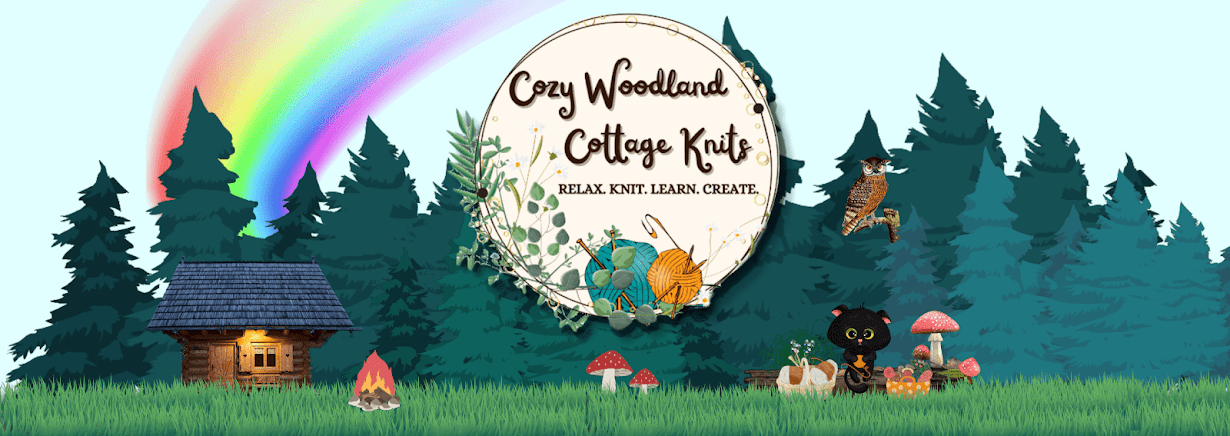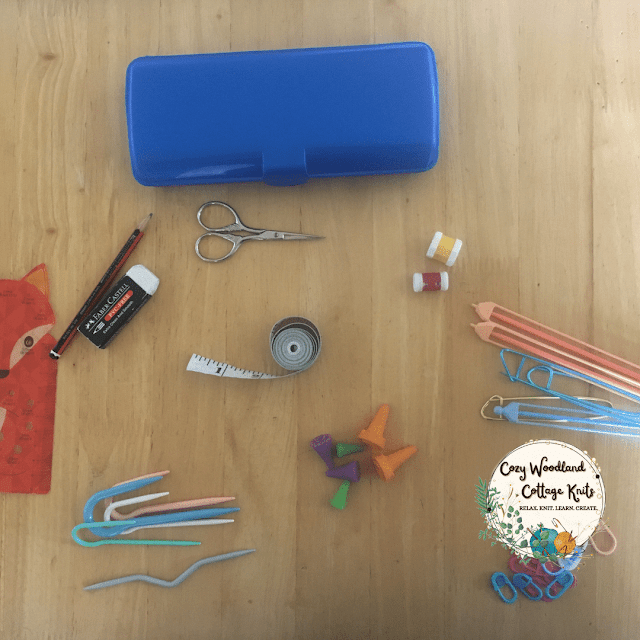Knitting accessories
Basic knitting kit
The basic knitting kit consists of all of the essentials every knitter should have in their knitting kit to get started learning how to knit. I went and bought my knitting needles along with all of the little bits and pieces I also got when I bought my knitting needles when I went and with my Nana when I started learning to knit except for a tape measure because Nana had quite a few of those laughs.
1. Pencil case
Keep everything together to save hunting for things in your knitting bag, it also helps keep things neat and tidy.
2. Scissors
Cut bits of yarn and ends that have been weaved in. Weaving the yarn is threading the yarn ends through the stitches at the back to hide them rather than just cutting them off which you could do but if the knot comes undone you will not be able to re-tie the yarn.
3. Yarn needle
These are used to weave loose ends in, you could also use a tapestry needle though these are harder to thread the yarn through depending on the thickness of the yarn used.
4. Row counter
For keeping track of rows, saves stopping and counting, trying to remember which row you are up to. You can also keep track of rows on pieces of paper or in a notebook. I used to use paper but found I often lost the paper and went through a lot of paper and with trying to reduce waste and live zero waste I decided to use a row counter instead.
5. Tape measure
A tape measure comes in handy when a pattern asks you to knit for so many cm or inches. It is also used if you need to take measurements for a hat or other garment like a jumper because there is nothing worse than knitting it and realizing it is either too small or too big. My tape measure is usually missing since my children like to play with them they make a great pet snake and skipping rope laughs.
6. A pencil and eraser
Add notes to patterns or any adjustments you would like to make or jot down any questions you may have when you first read the pattern. Often it is easier to ask these before you start the pattern but if you have already started knitting and gotten stuck that is ok too sometimes things make sense when you read them but do not when it comes to knitting that bit. A pencil and eraser are also great if your knitting pattern has different sizes as you can circle which size you are making which helps you to follow the pattern more easily.
Handy extras
[Start of image description: On top of a wooden table is a fox-shaped knitting needle gauge with an 8 above it and needlepoint protectors next to it with a number 7 next to it. End of image description.]
8. Knitting needle gauge
These are used to work out the size of knitting needles if their size of them has worn off over time. They are perfect if you have been given some by a friend or family member or picked some from a second-hand shop often they quite a good range of them.
Knitting extras
These knitting accessories are great to add to your knitting kit once your knitting skills grow or depending on your skill level you may already need some of them. How do you know when you'll need them? The easiest answer is when a knitting pattern says however This way it is also great for your budget if you have any and clutter by not buying anything unnecessary that isn't going to get used, I am a cozy minimalist and I hate having things sitting that are not necessary or being used.
[Start of image description: On top of a wooden table is needle point protectors with a number 7 above them and a fox-shaped knitting needle gauge underneath with a number 8 next to it. To the right are stitch holders with a number 9 next to them and stitch markers with a number 10 next to them. On the left are u-shaped and v-shaped cable needles with an 11 next to them. End of image description.]
I know I mentioned these above and I am adding them here too because I found another use for them - I have a habit of trying to find multiple uses for items though not all of them work out right. Needle point protectors are awesome if you are using double-pointed needles for the first time. Sure you have to take them off and put them back on at the end of each knitting needle which may be annoying but it stops you from dropping the stitches everywhere. I found taking them off less annoying than picking up dropped stitches or making a big mess and having to start again. I may have cried about making a big mess and starting again a few times ok it was a lot and why I thought of using these in the first place.
8. Knitting needle gauge
Yes, another one I listed above for a different reason. Once the needle size wears off double pointed needles (DPNs) or circular needles the knitting needle gauge comes in handy. It's impossible to tell what the size is any other way, putting coloured tape on them before the size comes off so you'll know what size it works well for straight needles. Sadly it will not work for double-pointed needles (DPNs) or circular needles as it catches on the stitches and just makes a mess of your knitting and the yarn. I have lost count of how many times I have used mine to check the size of my double-pointed needles.
9. Stitch holders
These are great for holding stitches on a project you've either had enough of knitting for a while or just want to try something different. While you can leave them on the knitting needle they do stretch over time and it ends up looking messy. Stitch holders are also used when knitting socks for holding stitches not in use, for necklines and sleeves on a jumper.
10. Stitch markers
These are to mark the start of the round (another name for a row but called a round as you knit in a circle) when doing circular knitting or knitting on double-pointed needles. They can also be used to mark parts of knitting where a pattern states.
11. Cable needle
If you would like to knit cables these are essential to hold the cable stitches in place. You can either get metal or plastic stitch holders they have like a little v in the middle of them to stop the stitches from falling off, If you are learning how to do cables for the first time I'd recommend getting the ones with a u bend in them as I've found these help stop the stitches from falling off a better than the v-shaped ones. Remember when I said earlier on in this post that I have a habit of trying to find multiple uses for items though not all of them work out right well this is one of those. I tried using a double-pointed needle (DPN) it did not work too well at all because 15mm is too long and it is very easy to bump all of the stitches off ops.
Here is my complete essential knitting kit, after over 10 years of knitting, all of these are used often.

Related posts
🌲How to organise your yarn stash
🌲Types of knitting needles













No comments:
Post a Comment